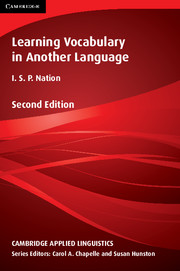Book contents
- Frontmatter
- Contents
- Series editors' preface
- Acknowledgements
- Introduction
- 1 The goals of vocabulary learning
- 2 Knowing a word
- 3 Teaching and explaining vocabulary
- 4 Vocabulary and listening and speaking
- 5 Vocabulary and reading and writing
- 6 Specialised uses of vocabulary
- 7 Vocabulary-learning strategies
- 8 Learning words from context
- 9 Word parts
- 10 Using dictionaries
- 11 Deliberate learning from word cards
- 12 Finding and learning multiword units
- 13 Testing vocabulary knowledge and use
- 14 Designing the vocabulary component of a language course
- Appendices
- Subject index
- Author index
13 - Testing vocabulary knowledge and use
Published online by Cambridge University Press: 15 February 2018
- Frontmatter
- Contents
- Series editors' preface
- Acknowledgements
- Introduction
- 1 The goals of vocabulary learning
- 2 Knowing a word
- 3 Teaching and explaining vocabulary
- 4 Vocabulary and listening and speaking
- 5 Vocabulary and reading and writing
- 6 Specialised uses of vocabulary
- 7 Vocabulary-learning strategies
- 8 Learning words from context
- 9 Word parts
- 10 Using dictionaries
- 11 Deliberate learning from word cards
- 12 Finding and learning multiword units
- 13 Testing vocabulary knowledge and use
- 14 Designing the vocabulary component of a language course
- Appendices
- Subject index
- Author index
Summary
Testing vocabulary is similar to testing in other areas of language knowledge and use. The same criteria of reliability, validity, practicality and washback need to be considered when designing and evaluating vocabulary tests (Nation and Webb, 2011). In some ways testing vocabulary is easier than testing grammatical knowledge or control of discourse because the units to test are more obviously separate. It is not too difficult to identify what a word type is. However, there are problems and issues and we will look at these in this chapter. There is an excellent book devoted solely to vocabulary testing (Read, 2000) and Schmitt's (2010) book on researching vocabulary focuses upon measurement.
Like much of this book, this chapter is organised around questions that teachers typically ask. This means that it is organised rather differently from some other discussions of language testing. This chapter has two major divisions. The first division looks at the purposes of vocabulary tests, covering diagnostic, placement, achievement and proficiency tests. The second division looks at different test formats or item types, answering questions like ‘Should choices be given?’, ‘Should words be tested in context?’ and ‘How can I measure words that learners don't know well?’ This section covers a wide range of vocabulary test formats, along with comments on their design and use.
When deciding which vocabulary test is the best, the test maker has to consider the purpose of the test, the kind of knowledge it will try to measure, and the conditions under which it will be used.
- Type
- Chapter
- Information
- Learning Vocabulary in Another Language , pp. 514 - 568Publisher: Cambridge University PressPrint publication year: 2013



